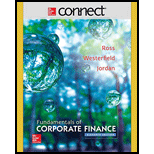
a)
To compute: The combined value of equity and debt in the two existing companies
Introduction:
Value of equity is the amount that comprises of the firm’s capital structure as equity shares. It is the total contribution of the equity shareholders to the firm. Value of debt is the amount that comprises of the firm’s capital structure as debt. It is the total contribution of the debt-holders to the firm.
b)
To compute: The value of equity and debt of the new firm.
Introduction:
Value of equity is the amount that comprises of the firm’s capital structure as equity shares. It is the total contribution of the equity shareholders to the firm. Value of debt is the amount that comprises of the firm’s capital structure as debt. It is the total contribution of the debt-holders to the firm.
c)
To calculate: The gain or loss for the shareholders and the bondholders.
Introduction:
Value of equity is the amount that comprises of the firm’s capital structure as equity shares. It is the total contribution of the equity shareholders to the firm. Value of debt is the amount that comprises of the firm’s capital structure as debt. It is the total contribution of the debt-holders to the firm.
d)
To discuss: The impact of a merger on shareholders.
Introduction:
Value of equity is the amount that comprises of the firm’s capital structure as equity shares. It is the total contribution of the equity shareholders to the firm. Value of debt is the amount that comprises of the firm’s capital structure as debt. It is the total contribution of the debt-holders to the firm.
Want to see the full answer?
Check out a sample textbook solution
Chapter 25 Solutions
Connect 1 Semester Access Card for Fundamentals of Corporate Finance
- A brief introduction and overview of the company"s (a) uk vodaphone (b) uk Hsbc bank, (c)uk coca-cola history and current position in respective marketplace.arrow_forwardKing’s Park, Trinidad is owned and operated by a private company,Windy Sports Ltd. You work as the Facilities Manager of the Park andthe CEO of the company has asked you to evaluate whether Windy shouldembark on the expansion of the facility given there are plans by theGovernment to host next cricket championship.The project seeks to increase the number of seats by building fournew box seating areas for VIPs and an additional 5,000 seats for thegeneral public. Each box seating area is expected to generate $400,000in incremental annual revenue, while each of the new seats for thegeneral public will generate $2,500 in incremental annual revenue.The incremental expenses associated with the new boxes and seatingwill amount to 60 percent of the revenues. These expenses includehiring additional personnel to handle concessions, ushering, andsecurity. The new construction will cost $15 million and will be fullydepreciated (to a value of zero dollars) on a straight-line basis overthe 5-year…arrow_forwardYou are called in as a financial analyst to appraise the bonds of Ollie’s Walking Stick Stores. The $5,000 par value bonds have a quoted annual interest rate of 8 percent, which is paid semiannually. The yield to maturity on the bonds is 12 percent annual interest. There are 12 years to maturity. a. Compute the price of the bonds based on semiannual analysis. b. With 8 years to maturity, if yield to maturity goes down substantially to 6 percent, what will be the new price of the bonds?arrow_forward
- Lonnie is considering an investment in the Cat Food Industries. The $10,000 par value bonds have a quoted annual interest rate of 12 percent and the interest is paid semiannually. The yield to maturity on the bonds is 14 percent annual interest. There are seven years to maturity. Compute the price of the bonds based on semiannual analysis.arrow_forwardNeed solution this wuarrow_forwardneed assarrow_forward
 EBK CONTEMPORARY FINANCIAL MANAGEMENTFinanceISBN:9781337514835Author:MOYERPublisher:CENGAGE LEARNING - CONSIGNMENT
EBK CONTEMPORARY FINANCIAL MANAGEMENTFinanceISBN:9781337514835Author:MOYERPublisher:CENGAGE LEARNING - CONSIGNMENT

